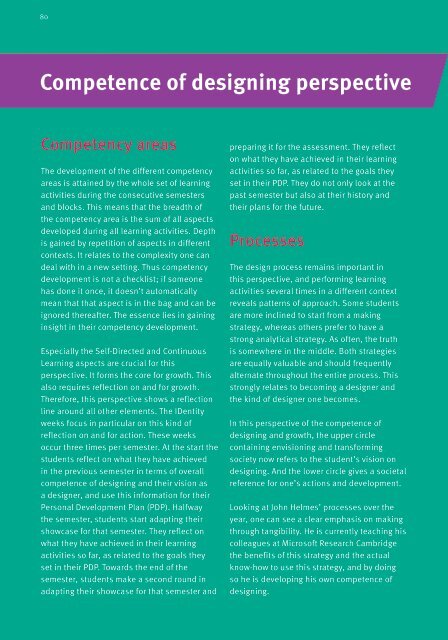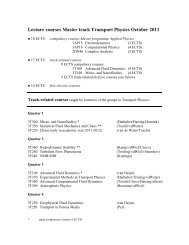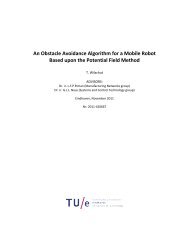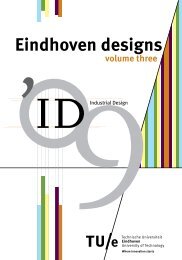Education guide 'Eindhoven designs' - Technische Universiteit ...
Education guide 'Eindhoven designs' - Technische Universiteit ...
Education guide 'Eindhoven designs' - Technische Universiteit ...
You also want an ePaper? Increase the reach of your titles
YUMPU automatically turns print PDFs into web optimized ePapers that Google loves.
80<br />
Competence of designing perspective<br />
Competency areas<br />
The development of the different competency<br />
areas is attained by the whole set of learning<br />
activities during the consecutive semesters<br />
and blocks. This means that the breadth of<br />
the competency area is the sum of all aspects<br />
developed during all learning activities. Depth<br />
is gained by repetition of aspects in different<br />
contexts. It relates to the complexity one can<br />
deal with in a new setting. Thus competency<br />
development is not a checklist; if someone<br />
has done it once, it doesn’t automatically<br />
mean that that aspect is in the bag and can be<br />
ignored thereafter. The essence lies in gaining<br />
insight in their competency development.<br />
Especially the Self-Directed and Continuous<br />
Learning aspects are crucial for this<br />
perspective. It forms the core for growth. This<br />
also requires reflection on and for growth.<br />
Therefore, this perspective shows a reflection<br />
line around all other elements. The IDentity<br />
weeks focus in particular on this kind of<br />
reflection on and for action. These weeks<br />
occur three times per semester. At the start the<br />
students reflect on what they have achieved<br />
in the previous semester in terms of overall<br />
competence of designing and their vision as<br />
a designer, and use this information for their<br />
Personal Development Plan (PDP). Halfway<br />
the semester, students start adapting their<br />
showcase for that semester. They reflect on<br />
what they have achieved in their learning<br />
activities so far, as related to the goals they<br />
set in their PDP. Towards the end of the<br />
semester, students make a second round in<br />
adapting their showcase for that semester and<br />
preparing it for the assessment. They reflect<br />
on what they have achieved in their learning<br />
activities so far, as related to the goals they<br />
set in their PDP. They do not only look at the<br />
past semester but also at their history and<br />
their plans for the future.<br />
Processes<br />
The design process remains important in<br />
this perspective, and performing learning<br />
activities several times in a different context<br />
reveals patterns of approach. Some students<br />
are more inclined to start from a making<br />
strategy, whereas others prefer to have a<br />
strong analytical strategy. As often, the truth<br />
is somewhere in the middle. Both strategies<br />
are equally valuable and should frequently<br />
alternate throughout the entire process. This<br />
strongly relates to becoming a designer and<br />
the kind of designer one becomes.<br />
In this perspective of the competence of<br />
designing and growth, the upper circle<br />
containing envisioning and transforming<br />
society now refers to the student’s vision on<br />
designing. And the lower circle gives a societal<br />
reference for one’s actions and development.<br />
Looking at John Helmes’ processes over the<br />
year, one can see a clear emphasis on making<br />
through tangibility. He is currently teaching his<br />
colleagues at Microsoft Research Cambridge<br />
the benefits of this strategy and the actual<br />
know-how to use this strategy, and by doing<br />
so he is developing his own competence of<br />
designing.

















